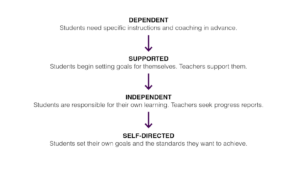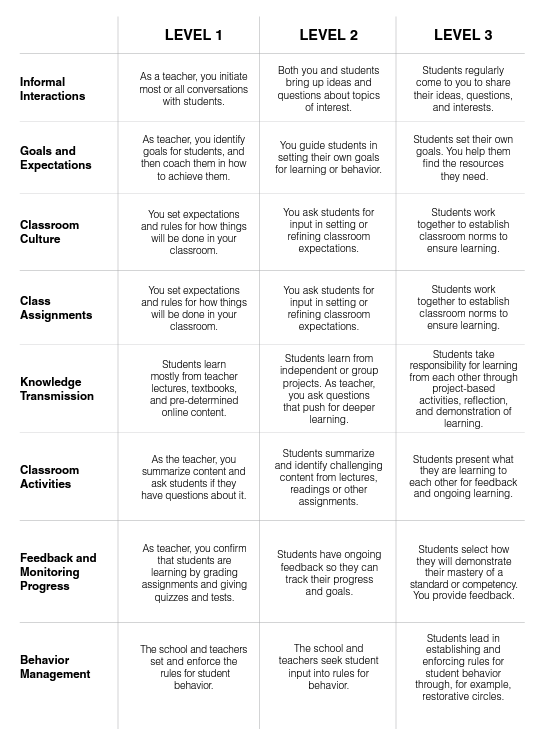Giving Students a Voice in the Classroom
In a typical school day, how many meaningful decisions about their role and learning do students get to make? Too often, the answer is “not many.” The educational system and teachers decide what students need to learn, when and how they will learn it, and how long it will take. Standardized tests determine whether they learned it. So it’s not unreasonable to ask: If students believe administrators and teachers hold all the power, why should they put in any effort in school? Does it really matter what they think and what’s important to them? If they don’t have any say, why speak up or step out?
Those are difficult, challenging and sometimes controversial questions. However, if the goal is for students to become self-motivated, responsible learners, a key strategy is to give them more voice and choice — more power — in their classrooms and schools. When students believe that what they think and say really matters, it unlocks their commitment to and potential for learning and for investing themselves in the school community. On the other hand, when teachers and administrators make all the decisions, students can become less motivated to learn and they become more passive and dependent on educators for their learning. That makes it harder for everyone.
As citizens go to the polls to select local, state and national leaders, it is fitting to ask about whether, how, and when students do, or should, have a voice in their schools and classrooms. In the process, we offer practical ways teachers and other educators can create opportunities can have more of a voice in their classrooms and schools.
The Critical Role of Friends Who Listen
In the past 20 years, researchers have learned a lot about student-centered learning, which includes an emphasis on student voice, student choices and other ways that teachers share power in their interactions and relationships with students.
The Power of Sharing Power in Classrooms
High school students who feel more empowered in learning are more likely to report higher grades, higher educational aspirations and fewer behavior incidents in school, according to a survey of 381 students in five urban high schools. What factors contribute to students feeling more empowered? When teachers have positive relationships and share power with students and when there’s a sense of community — relationships with other students — in the classroom.
Teachers and Students: Different Perspectives
Teachers may believe they are asking students for their input, but students may not see themselves having opportunity for input. In May 2016, Search Institute pilot tested The Pulse Survey for Jostens Renaissance in eight schools, surveying 2,448 students and 118 teachers. They asked both teachers and students how many teachers asked students’ opinions “when making decisions that could affect them.”
Who is right? The best way to answer that question is to talk with students and teachers about their own experiences in the school. Perhaps teachers are doing things that students don’t notice. Perhaps students are focused on decisions that teachers haven’t considered. Just the conversation can open up new opportunities for exploring when and how students have a voice in decisions that affect them.
What Does Sharing Power Look Like in Classrooms?
A shift to learner-centered teaching results in a classroom in which an adult lectures to students sitting in rows every day. A panel of experts worked together to identify what educators do to encourage student voice and choice (or agency) and student ownership in learning. They see effective educators doing the following:
-
- – Offering students choices in the curriculum and co-designing learning experiences.
- – Giving students opportunities to set their own goals and monitor their progress.
- – Providing students with several options to demonstrate mastery or competence.
- – Creating opportunities for students to make decisions, solve problems, and contribute to classroom learning and climate.
Shifting Power to Students: A Growth Process
Students don’t start out ready to be independent, autonomous learners. Rather, they need responsibility to shift to them as they become more and more competent and self-directed. Thus, shifting power in teacher-student relationships can happen anywhere along a continuum:
Strategies to Help Students Become Autonomous Learners
The central goal of sharing power with students is to develop their ability to learn independently and to take responsibility for their own actions, choices and learning. Researchers find that teachers nurture this kind of autonomy at the middle school level when they do the following:
-
- – Give student opportunities to move around, work with others and make choices about their learning.
- – Help students identify their own interests, goals and values.
- – Explicitly show links between what is being learned and students’ own life plans.
- – Show flexibility, following students’ ideas, leads and perspectives.
- – Integrate students’ ideas into planning activities.
- – Ask questions that push students to think through problems and improve their skills.
- – Introduce students to multiple viewpoints so they have to think through their own perspectives.
- – Letting students disagree and criticize as ways of helping them feel safe expressing their opinions and feelings.
Barriers to Sharing Power with Students
Though educators have long known about the value of student-centered learning, most teaching still focuses primarily on teachers conveying what they know to students — most often through lectures. Then teachers evaluate whether students have learned what the teachers wanted them to learn. When researchers investigate why teachers resist student-centered approaches, they find the following barriers at work:
-
- – Teachers want to show what they know.
- – They are supposed to cover too much content.
- – Using new approaches is initially awkward.
- – Teachers feel more vulnerable when teaching is less scripted.
Often, however, teachers start with other ways to share power. This might include giving students choices in their assignments or deadlines, working with students to set classroom policies and expectations, or creating together the criteria that will be used in assessments.
Student Centered Isn’t “Hands Off”
“Student-centered” learning does not mean “hands-off” teaching. A review of two decades of research on teacher-student relationships suggests that students do better educationally when teachers both communicate what they know effectively while also giving students freedom and responsibility during group and independent work. But the way the teachers use their influence also matters. When teachers are oppositional, admonishing or dissatisfied, students are less likely to learn. When they are cooperative and warm, students become more engaged and learn better.
This kind of relationship — characterized by both high teacher influence and a cooperative spirit — is also what both students and teachers say they prefer. When teacher-student relationships are characterized by this kind of high influence and cooperation, researchers also find lower levels of discipline problems as well as lower levels of teacher stress and burnout.
Sharing Power and Classroom Authority
People often object to the idea of sharing power because it implies giving up classroom authority and control. However, researchers find just the opposite: When teachers form strong relationships with students that include sharing power and support for students’ autonomy, students are more likely to recognize the legitimacy of the teachers as authority figures.
A study in Portugal found that “a focus on interpersonal relationship strategies that take student interests into account, presents options and minimizes the use of coercive strategies” resulted in students seeing teachers exercising their authority legitimately. However, if students are in an environment that does not support their autonomy (or share power), they are less likely to see teachers as legitimate authority figures.
Sharing Power with Students: A Rubric for Reflection
This rubric suggests a continuum of ways educators encourage students to take more and more responsibility and feel more ownership for their learning by giving them choices and a voice. Circle the statement in each row (on the next page) that best reflects your most common practices as a teacher (knowing they can vary from day to day and from class to class). Then identify one or two areas where you believe it would help students to shift practices one column to the right. Identify specific actions you could take to begin moving in that direction.
Jostens partnered with Search Institute to provide research-based data and advice for dealing with common school challenges. Over the past 30 years, Search Institute has studied the strengths and difficulties in the lives of more than five million middle and high school youth across the country and around the world to understand what kids need in order to succeed. Like Jostens Renaissance, Search Institute focuses on young people’s strengths, rather than emphasizing their problems or deficiencies. Visit SearchInstitute.org to learn more.
Click the button below to download and print all research, references, and accompanying activities for Giving Students a Voice in the Classroom.
WANT TO USE JOSTENS RENAISSANCE?
If you are a Jostens customer and you need a login to access all the resources on JostensRenaissance.com, email your rep or click here.
If you don’t currently partner with Jostens for yearbooks or graduation regalia or other celebratory products, you can learn more here.



